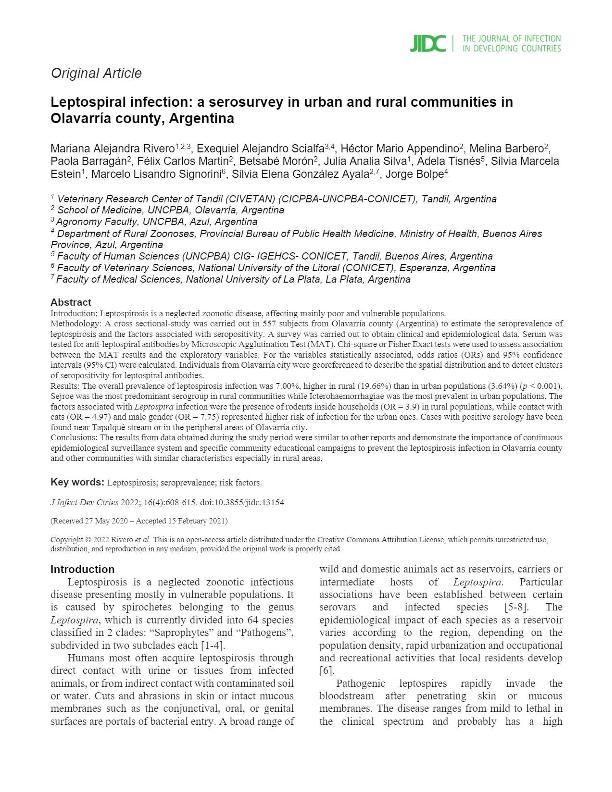Artículo
Leptospiral infection: a serosurvey in urban and rural communities in Olavarría county, Argentina
Rivero, Mariana Alejandra ; Scialfa, Exequiel Alejandro; Appendino, Hector Mario; Barbero, Melina; Barragán, Paola Gabriela; Martin, Felix Carlos; Morón, Betsabé; Silva, Julia Analia; Tisnés, Adela
; Scialfa, Exequiel Alejandro; Appendino, Hector Mario; Barbero, Melina; Barragán, Paola Gabriela; Martin, Felix Carlos; Morón, Betsabé; Silva, Julia Analia; Tisnés, Adela ; Estein, Silvia Marcela
; Estein, Silvia Marcela ; Signorini Porchietto, Marcelo Lisandro
; Signorini Porchietto, Marcelo Lisandro ; Gonzalez Ayala, Silvia Elena; Bolpe, Jorge
; Gonzalez Ayala, Silvia Elena; Bolpe, Jorge
 ; Scialfa, Exequiel Alejandro; Appendino, Hector Mario; Barbero, Melina; Barragán, Paola Gabriela; Martin, Felix Carlos; Morón, Betsabé; Silva, Julia Analia; Tisnés, Adela
; Scialfa, Exequiel Alejandro; Appendino, Hector Mario; Barbero, Melina; Barragán, Paola Gabriela; Martin, Felix Carlos; Morón, Betsabé; Silva, Julia Analia; Tisnés, Adela ; Estein, Silvia Marcela
; Estein, Silvia Marcela ; Signorini Porchietto, Marcelo Lisandro
; Signorini Porchietto, Marcelo Lisandro ; Gonzalez Ayala, Silvia Elena; Bolpe, Jorge
; Gonzalez Ayala, Silvia Elena; Bolpe, Jorge
Fecha de publicación:
04/2022
Editorial:
Journal of Infection in Developing Countries
Revista:
Journal of Infection in Developing Countries
ISSN:
1972-2680
e-ISSN:
1668-3498
Idioma:
Inglés
Tipo de recurso:
Artículo publicado
Clasificación temática:
Resumen
INTRODUCTION: Leptospirosis is a neglected zoonotic disease, affecting mainly poor and vulnerable populations. METHODOLOGY: A cross sectional-study was carried out in 557 subjects from Olavarría county (Argentina) to estimate the seroprevalence of leptospirosis and the factors associated with seropositivity. A survey was carried out to obtain clinical and epidemiological data. Serum was tested for anti-leptospiral antibodies by Microscopic Agglutination Test (MAT). Chi-square or Fisher Exact tests were used to assess association between the MAT results and the exploratory variables. For the variables statistically associated, odds ratios (ORs) and 95% confidence intervals (95% CI) were calculated. Individuals from Olavarría city were georeferenced to describe the spatial distribution and to detect clusters of seropositivity for leptospiral antibodies. RESULTS: The overall prevalence of leptospirosis infection was 7.00%, higher in rural (19.66%) than in urban populations (3.64%) (p < 0.001). Sejroe was the most predominant serogroup in rural communities while Icterohaemorrhagiae was the most prevalent in urban populations. The factors associated with Leptospira infection were the presence of rodents inside households (OR = 3.9) in rural populations, while contact with cats (OR = 4.97) and male gender (OR = 7.75) represented higher risk of infection for the urban ones. Cases with positive serology have been found near Tapalqué stream or in the peripheral areas of Olavarría city. CONCLUSIONS: The results from data obtained during the study period were similar to other reports and demonstrate the importance of continuous epidemiological surveillance system and specific community educational campaigns to prevent the leptospirosis infection in Olavarría county and other communities with similar characteristics especially in rural areas.
Palabras clave:
LEPTOSPIROSIS
,
RISK FACTORS
,
SEROPREVALENCE
Archivos asociados
Licencia
Identificadores
Colecciones
Articulos(CIVETAN)
Articulos de CENTRO DE INVESTIGACION VETERINARIA DE TANDIL
Articulos de CENTRO DE INVESTIGACION VETERINARIA DE TANDIL
Articulos(IGEHCS)
Articulos de INSTITUTO DE GEOGRAFIA, HISTORIA Y CS. SOCIALES
Articulos de INSTITUTO DE GEOGRAFIA, HISTORIA Y CS. SOCIALES
Citación
Rivero, Mariana Alejandra; Scialfa, Exequiel Alejandro; Appendino, Hector Mario; Barbero, Melina; Barragán, Paola Gabriela; et al.; Leptospiral infection: a serosurvey in urban and rural communities in Olavarría county, Argentina; Journal of Infection in Developing Countries; Journal of Infection in Developing Countries; 16; 4; 4-2022; 608-615
Compartir
Altmétricas



